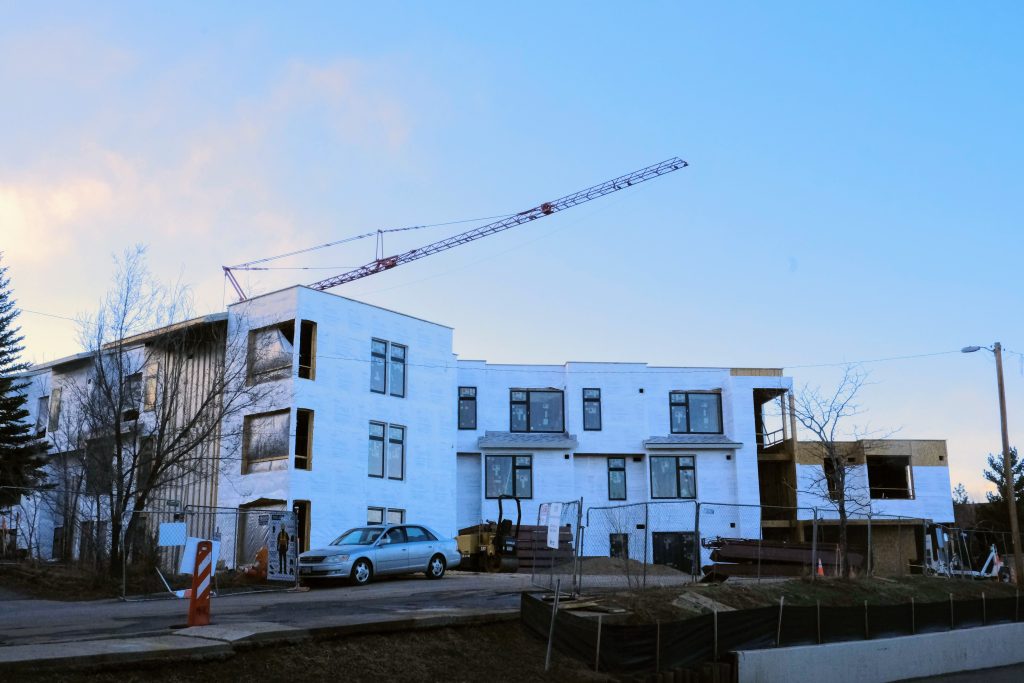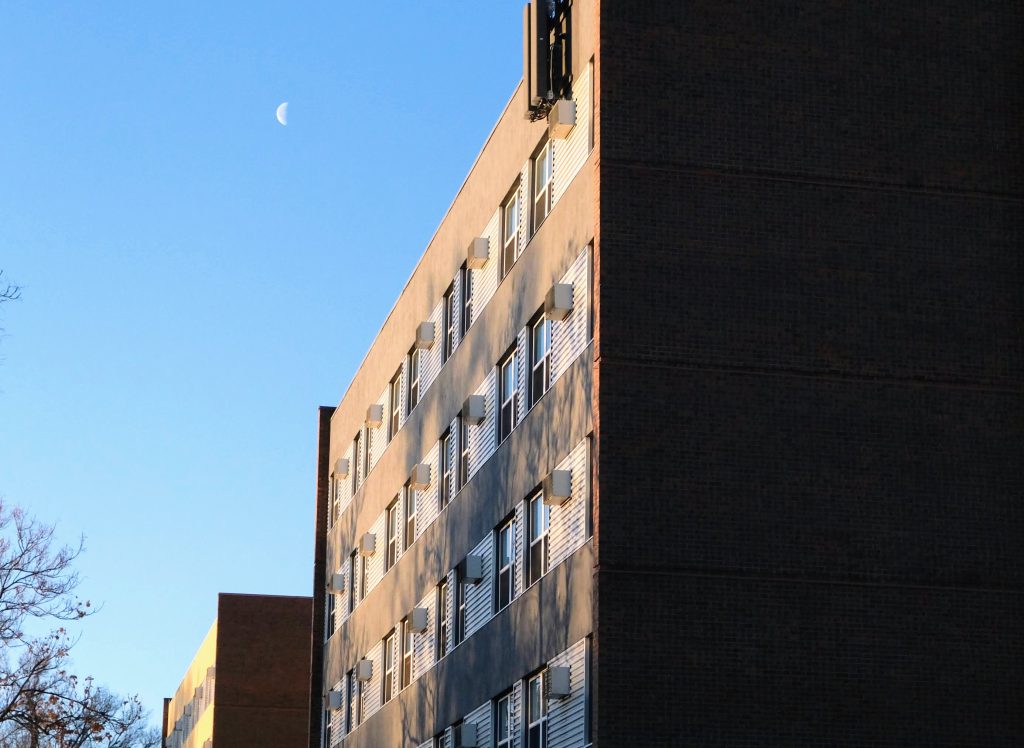
Joel Sprenger lives in Boulder for one thing.
Last year, he scrambled to 184 Flatiron summits between the First and the Fifth. He can bag all five of them in one three-hour push, he says proudly.
When he’s not scaling rock, Sprenger might be zooming DoorDash orders around town on his electric bike. But he’s “basically here” because of the Flatirons, he says. “I don’t think I’m going to find anything better than what I’ve got going on here.”
If the great outdoors are the why, Boulder Housing Partners (BHP) is the how. Sprenger just signed on for another year renting from the city’s public housing authority (PHA). He’s lived in the same apartment for six years and says he probably couldn’t live in town if it wasn’t for BHP or another source of affordable housing.
“The thing I like the most,” he says, “they just leave me alone.”
Not everyone has such a positive experience living in BHP’s housing. Rhonda McManus-Tatum lived in one of their apartments for a few years with her husband, who is a veteran with PTSD. They moved out last year because of maintenance issues and feeling “unimportant” or “ignored” by their property manager.
“I’m literally borrowing money to live elsewhere,” she says. “I can’t afford where I’m living, but it’s worth not having to deal with that.”
McManus-Tatum is not alone. Complaints about BHP have flowed steadily through various channels, making their way to elected officials. Within the past year, there was enough noise from residents and the community about drug use, behavioral issues and criminal activity at BHP properties that the organization decided to adjust how it screens for residents.
“Whether it’s a maintenance issue, whether it’s a lack of transparency, whatever the issue is, there’s a subset of people who don’t seem to feel like anybody is personally invested in them and their wellbeing at BHP,” says Boulder City Councilmember Nicole Speer.
BHP feels confident that its residents are mostly happy. Multiple sources interviewed for this story, who declined to be quoted, say the same people complain about BHP, and there aren’t many of them.
But it’s difficult to know exactly how happy or unhappy residents really are. While the housing authority collects feedback in a few ways, there isn’t a standardized metric to capture tenant satisfaction or compare it over time — at BHP or any other public housing authorities in the county.
Three area PHAs are collectively adding thousands of homes as they try to address Boulder County’s severe housing crisis. Yet officials say their resident services programs are underfunded, understaffed and still recovering after the end of COVID-era funding and a rise in mental health needs.
“At least for BHP, I really do believe that their heart is in the right place, and they are really trying to serve the community,” Speer says. “They’re also a landlord. They are trying to build more housing, they have been building a lot of housing relatively quickly. They’ve been growing a lot.
“Anytime you’re growing quickly, you’re gonna have some growing pains.”
‘Your metric is perfection’
Public housing authorities are quasi-governmental entities that build, own and manage affordable homes using a mixture of public and private dollars. There are more than 50 of them in Colorado, including the three in Boulder County: BHP, Longmont Housing Authority (LHA) and Boulder County Housing Authority (BCHA).
Public housing authorities are important players in the affordable housing industry across the country: One quarter of federally assisted housing stock are owned or managed by them.
They fill an essential need locally, too. Boulder’s rental gap — which compares the supply of rental housing to demand — is estimated at a deficit of nearly 4,000 units affordable to households with annual incomes at or below $35,000. Forty-five percent of renters in the city fall in that category, according to the 2020-2024 Consolidated Plan created by the cities of Boulder, Broomfield and Longmont, and Boulder and Broomfield Counties.
Longmont is 2,526 units behind. The county-wide gap is estimated at 11,500.
BHP is the largest developer of affordable housing in Boulder for people like Sprenger and McManus-Tatum. It manages more than half of the city’s affordable units — nearly 1,600 — and it’s growing: 41% (655) of those units have been added since 2016, and 700 more are in the pipeline.
Most of those homes house people who earn 30% of the area median income (AMI) or less: $27,900 per year for a single person. As of last year, the average income of all BHP households was $17,000 per year.
Other public housing authorities in the county are keeping pace with BHP’s rapid development of affordable units. BCHA has added 96% more units since 2012 and now manages over 900, with hundreds more on the way. The smaller LHA, which manages 462 units, will have added 30% more units (139) since 2018 by the end of this year.
BHP is consistently recognized for its programs and developments, winning state and national awards. Kurt Firnhaber, Boulder’s housing and human services director, also says the organization has “probably one of the best batting records” in getting competitive state tax credits essential for affordable housing developments.
“They’re better than everybody else,” says Boulder City Councilmember Mark Wallach, who also sits on the BHP Board of Commissioners. “And objectively speaking, they’re extremely good.
“Unless your metric is perfection, they’re not going to fall short.”
‘We need a way for everybody to be housed’
Sprenger says the only problems he’s had in his apartment haven’t been with BHP, but rather other residents.
He recalls the early stages of the pandemic after a person he believed to be using drugs and previously homeless moved into his building, and “the front turned into a homeless camp.” Sprenger thought BHP was trying to evict them, but felt nothing was ultimately done even after contacting the police.

Housing authorities like BHP increasingly provide affordable options for people exiting homelessness, some of whom may be struggling with substance abuse or mental health. Keeping them housed presents a challenge to both the organization and other residents.
Complaints from residents about people perceived to be previously homeless have reached local elected officials. Boulder City Councilmember Tara Winer told Boulder Beat she pursued policy changes in affordable housing on behalf of residents upset about drugs, crime and untreated mental illness in their buildings.
Two years ago, she says, “there were not the supportive services that there needed to be” to keep those people housed because of limited resources.
“The population with co-occurring disorders obviously has more problems living with others,” says Winer. “They’re not used to being away from their community. If they were just recently unhoused, sometimes they bring those people in to hang out at their homes. Sometimes they still have substance abuse issues, and meth contamination occurs.”
BHP Executive Director Jeremy Durham says issues around substance abuse are “constantly threatening to become a big issue for our organization.”
“The costs for remediation are extraordinarily high, and then the cost to the community is extraordinarily high,” Durham says. “Because it’s scary when you come home and then it’s like, do not cross yellow tape or the hallway is Saran-wrapped up, or suddenly somebody’s coming in to test your unit and see if there’s cross contamination.”
After two units were contaminated with meth in 2023, and residents voiced concern to staff about related behavioral issues and criminal activity, BHP made changes to how they screen potential residents with more emphasis on criminal backgrounds and references. So far, Durham says the new process has been successful.
Drug use is an issue elsewhere, too. Seven units are down at LHA because of meth as of March 21, according to Molly O’Donnell, the division director. Full remediation costs typically vary between $120,000 and $150,000 for a one-bedroom unit, but some have gotten close to $200,000, LHA staff said during a Feb. 20 advisory board meeting.
“The harsh reality is there aren’t good solutions for known methamphetamine users to be housed,” says Durham. “And when we think about the overall system and just commitment to human dignity, we need a way for everybody to be housed. Right now, that doesn’t exist.”

BHP houses more than 200 individuals who were formerly homeless — about four times more than BCHA, which has half the units. Durham says the number of previously unhoused people in BHP apartments has increased over the last four to five years due to more voucher resources going to that demographic and difficulties people face to use vouchers with other landlords in the community.
Durham says it can be difficult to balance dual goals of keeping people housed and maintaining quality communities.
“Customer service is one of several competing priorities in some instances,” Durham wrote in an email response to followup questions. “Otherwise, then the thing to do would be to have people lose their housing with a pretty tight trigger finger when a lease violation may have occurred, and it’s part of our mission to not only get people housed but to keep people housed.”
Winer, who was involved in BHP’s process to enhance how it screens residents, calls it a tradeoff.
“The problem is, if they get evicted, then it’s really hard for them to find housing again,” she says. “They have it on their record. … People care and they don’t want to evict them, but sometimes they have challenged behavior. So what do we do? How do we keep the quality of life good for the families, for instance, the kids that are running around playing at the affordable housing, and also help these people? It’s really not an easy problem to solve.”
Nowhere else to go
McManus-Tatum’s husband was homeless when he first came to town around 2013.
“He came through, and people bought his art and offered him to stay in their houses, and it kind of really reminded him that humanity existed,” McManus-Tatum says. “So he decided to come back to society.”
In 2019, after he met McManus-Tatum out of state, they packed up a car and moved to Boulder together with the hope of making the town a permanent home through its supportive services. They stayed with some friends for a while and eventually got into a BHP apartment after having a baby.
“[BHP is] the only way I could afford to live here when we moved here and decided to have our son,” she says.
While affordable housing allowed her to live in Boulder, she felt trapped with limited to no alternatives. When she started experiencing conflict with management, she didn’t speak out as a resident until she had other housing secured.
“I could not say anything until I moved, because I didn’t know where else I was gonna go,” she says. “I had nowhere else to go.”
Speer says it can be hard for people to build trust over inherent power differentials in the landlord-tenant relationship, “especially when you are working with groups of people who have no reason to trust systems of power.
“You can be as kind and as wonderful and as welcoming and as open as you can be,” she says. “But when you control someone’s housing, and you make a decision about whether they stay or not, you’re gonna think twice about whether you can really be honest, and how honest can you be.”
Relying on Google Reviews
Collecting resident satisfaction is a tricky endeavor, especially from tenants about their landlord — a relationship that can be influenced by anything from annoying neighbors and housing quality to maintenance turnaround times. Those factors can sometimes be out of management’s control.
McManus-Tatum left a one-star review on a BHP Google Reviews page that is overwhelmingly positive. With an average of 4.6 stars from 248 reviews in the last seven years — a fairly small sample for an organization serving more than 4,000 residents — Durham says the page is an accurate representation of overall resident satisfaction.
Nearly half of those reviews have been posted since February 2023 and about 14% in the last three months. Durham says the increase is because BHP has gotten more intentional about directing people to the review page, through measures like posting QR codes on staff desks.
But when a lower rating does come up, common themes surround communication or maintenance issues.
“When you are serving 4,400 people, and when you’re an organization of 100, there’s going to be complaints — I think that’s an inevitability,” Durham says, adding that it’s “relatively common” that complaints on Google are from people in violation of their lease or someone who doesn’t actually live in a BHP apartment.
For example, one disgruntled resident reached out to Boulder Weekly with a complaint about the timing of BHP replacing the boiler in their mother’s building in November 2023. But the apartment was in a Boulder County complex called Lydia Morgan. While this resident didn’t write a review, it shows the kind of confusion in the community and the potential for an inaccurate or false online reviews.
While BHP uses Google Reviews for broader quantitative data, an ex-property manager who left the organization in 2023 feels like the system was biased.
“When I used to work there, they did Google Reviews,” says Christina, who requested to be referenced using a pseudonym. “But to be honest, we contacted the good residents — the ones we know were happy.”

Durham says Google Reviews is “one of the ways we get feedback, but there is a whole host of other more important ways,” and that reviews are “not the part where we’re trying to really emphasize negative feedback.”
Survey data has been collected by BHP, but they are not the same standardized questions from year to year. The most recent customer service survey, distributed in 2022 to all BHP residents, recorded 347 responses; 68% of residents said they were “Very Satisfied” or “Satisfied.” Just over 14% were “Dissatisfied” or “Very Dissatisfied.”
Another survey, given to all residents in 2019, reported similar, mostly positive feedback and showed low satisfaction from only a few residents in certain apartment buildings.
Durham says BHP collects survey data about every other year, but declined to share specifics when asked for more information on the exact number of surveys distributed over the last decade, or their results. According to Durham, the organization is more focused on community meetings, which he says provide the most direct and honest feedback.
He is “eager to roll something out that captures that in a scientific way so that we can tie it over time,” like a more standardized poll, Durham says. BHP is also about to launch a point-of-service survey that will follow things like maintenance requests, according to Durham.
Public housing authorities are “encouraged” but not required to gather feedback from residents by the U.S. Department of Housing and Urban Development (HUD), which oversees them.
Boulder County and Longmont don’t conduct resident satisfaction surveys and, like BHP, prefer community meetings. Boulder County Housing and Human Services (HHS), which manages resident services for BCHA properties, is working to better understand resident needs post-COVID through a satisfaction survey or needs assessment.
“We’re not offering as many points as we could to let residents who don’t want to provide feedback in an in-person setting,” says Gwen Mossman, a county supportive housing unit manager.
Mossman says they can use indicators like turnover rate that might show tenant satisfaction, but that doesn’t necessarily translate to happiness.
“Especially with this needs assessment,” she says. “I think that’s definitely the next step, to [figure out] are people actually really happy here.”
A HUD spokesperson wrote in an email that it doesn’t administer a resident satisfaction survey because “even poor performing PHAs may receive high resident satisfaction survey results, leading to doubts about its effectiveness in assessing areas of concern.”
Alexandra Nassau-Brownstone, vice president at Stewards of Affordable Housing for the Future, a collaborative of some of the largest nonprofit affordable housing developers around the country, says it’s important to offer multiple avenues for residents to engage.
“When you have a community meeting, that’s a great opportunity for open engagement. But not everyone can make it at that time,” she says. “They have children they have to cook dinner for, or they don’t feel safe coming out at night or whatever the conflict or scheduling might be. Increasingly, we are seeing organizations start to embrace technology and provide surveys and outreach in multiple formats, and we think that’s important.”
Tied up
Ex-property manager Christina was the point-person for residents at nine of the BHP properties she managed with a team of two others. On average, she says each team member was responsible for roughly 100 units.
Most of her time was spent on research, administration and following regulations, compared to time focused on residents. She says that balance was easy for her because she was organized, but knew of other teams that fell behind.
“You’re not only doing your administrator job, it’s more like psychology,” she says. “And not everybody knows how to do that.”
Durham says BHP is working to free up staff from the “tremendous bureaucracy of affordable housing” so they can be more available for resident needs.

“We spend an extraordinary amount of the organization’s limited resources verifying people’s income — almost all of whose income has already been verified by another government agency,” he says. “And that strikes me as a tremendous waste of time and resources. It also strikes me as extremely inequitable, from the perspective of our residents.”
Those processes also impact prospective residents. Christina shared a scenario where a single mom applied for housing but couldn’t prove her ex-partner’s address because he didn’t have a permanent home. Without it, she couldn’t get in.
“You’re cutting an opportunity for somebody who’s trying really hard to work hard for her family, and just because one sheet of paper is not there?”
HHS’ feedback processes for BCHA tenants have been hindered by limited resources and staff. Mossman’s team consists of five people covering 1,800 vouchers and units. In an ideal scenario, she says her staff would be twice that size.
Because of that, she says, “We’re not as deeply involved at each property as we probably would like to be if we could just be fully staffed throughout our portfolio.”
Right now, Mossman says there aren’t additional staff joining her team to pair with the development of 400 units at Willoughby Corner in Lafayette, which BCHA will have to manage.
Few ‘make noise’
Pam Griffin, who was president of BHP’s resident representative council (RRC), now called the resident advisory council, says she enjoys the quality of life at her senior BHP property.
“People don’t have to feel embarrassed about where they live,” she says. “They can say, ‘Look where I live,’ and they are proud of it. That’s pretty special.”
BHP
• Total units: 1,597
• Occupancy rate: 97%
• Google Review: 4.6 stars,
248 reviews
• Average workorder turnaround time: 4.48 days
LHA
• Total units: 462
• Occupancy rate: 92%
• Google Review*: 4.0 stars,
16 reviews
• Average workorder turnaround time: Doesn’t measure an actual average, but it’s estimated at 1-3 days, depending on the property
BCHA
• Total units: 908
• Occupancy rate: 92.6%
• Google Review*: 2.4 stars, 9 reviews
• Average workorder turnaround time: Not tracked; staff say work orders vary in time and response
*LHA and BCHA don't use data from Google Reviews.
Editor's note: The Michaels Organization, Allison Management and Thistle, private affordable housing developers in Boulder, did not respond to requests for interviews.
Her role on the RRC was to hold open meetings for residents once a month and represent tenants on the board of commissioners. Meeting attendance usually varied between 10 and 20 people, which dropped during COVID but rebounded after. She says neighbor and maintenance issues were frequently brought up.
Griffin thinks there are a few people who “make noise” about living in BHP housing — most everyone she knows is happy to be there. Other people interviewed for this article agreed.
Speer says residents who write to council with complaints are often the same people, which makes it “easy to dismiss when it’s just a couple people telling you the same thing over and over.”
Complaining can also be a matter of availability and privilege.
“The people who are most vocal are often the people who have the most time and energy to be vocal,” says McManus-Tatum. “That’s how I felt when I lived there. Like, I didn’t have the energy or time or mindspace. We were in COVID. We had a young child. I didn’t have the energy to chase after my maintenance people and make sure it got done.”
Inequities like these are why there’s extra responsibility that comes with taking care of people in affordable housing, Speer says.
“Often the people who are in affordable housing are disproportionately coming from historically and currently marginalized groups,” she says. “Particularly in a city that has a racial equity plan that is focused on creating more equity, I do think we have a different responsibility to the people who are living in affordable housing, an extra responsibility. That’s what equity is, right? It’s not just providing equality, but it is trying to account for past injustices and past harms, and trying to make things better.”
Moving forward
It’s a lot of weight on the shoulders of affordable housing providers to prioritize equity while keeping some of the most vulnerable community members happy and housed, especially as they add more units.
But Durham believes BHP’s growth doesn’t negatively impact residents already in their units. Rather, he says, it gives the public housing authority more resources to address issues.
“I think it unquestionably allows us to improve quality of service, because we get better economies of scale,” he says, adding they’ve put more emphasis on customer service in the last year through developing systems like followup maintenance requests with automated emails asking for feedback, adopting electronic payments for rent and hiring a deputy director to lead the effort.
According to its annual reports, BHP’s staff has grown by 17% since 2016. As of last year, 28 staff were dedicated to maintenance, 12 in resident services and 25 in property management.
BHP’s housing and resources are intimately tied to other citywide organizations like Boulder Shelter for the Homeless, Mental Health Partners and Boulder Food Rescue that serve overlapping demographics. Because of that, Firnhaber at the City of Boulder says the satisfaction of BHP residents goes beyond one singular organization: It is the responsibility of the entire city.
“We all have to sort of work together on that,” he says. “They are a housing organization. They’re not a human service organization. They’re not a health organization.”
Editor’s note: Reporter Will Matuska has lived in a BHP apartment for nearly two years.
